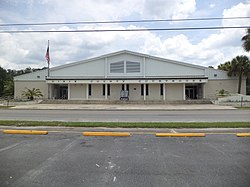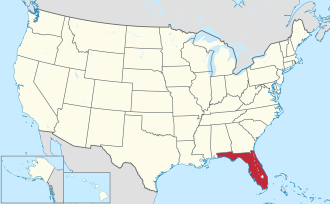2020 Census
The 2020 United States census counted 16,759 people, 6,248 households, and 3,905 families in Dixie County, Florida. [20] [21] The population density was 23.8 per square mile (9.2/km2). There were 9,276 housing units at an average density of 13.2 per square mile (5.1/km2). [21] [22] The racial makeup was 83.88% (14,057) white or European American (82.05% non-Hispanic white), 9.37% (1,571) black or African-American, 0.36% (61) Native American or Alaska Native, 0.38% (64) Asian, 0.02% (4) Pacific Islander or Native Hawaiian, 1.28% (214) from other races, and 4.7% (788) from two or more races. [23] Hispanic or Latino of any race was 4.11% (688) of the population. [24]
Of the 6,248 households, 24.7% had children under the age of 18; 43.3% were married couples living together; 25.9% had a female householder with no spouse or partner present. 29.9% of households consisted of individuals and 15.8% had someone living alone who was 65 years of age or older. [21] The average household size was 2.4 and the average family size was 3.0. [25] The percent of those with a bachelor’s degree or higher was estimated to be 7.2% of the population. [26]
18.1% of the population was under the age of 18, 6.1% from 18 to 24, 23.1% from 25 to 44, 29.5% from 45 to 64, and 23.2% who were 65 years of age or older. The median age was 47.5 years. For every 100 females, there were 79.8 males. [21] For every 100 females ages 18 and older, there were 77.3 males. [21]
The 2016-2020 5-year American Community Survey estimates show that the median household income was $41,674 (with a margin of error of +/- $1,917). The median family income was $47,188 (+/- $8,669). [27] Males had a median income of $32,985 (+/- $2,117) versus $21,214 (+/- $3,480) for females. The median income for those above 16 years old was $27,358 (+/- $5,285). [28] Approximately, 11.9% of families and 16.8% of the population were below the poverty line, including 27.4% of those under the age of 18 and 9.7% of those ages 65 or over. [29] [30]
2000 Census
In 2000 there were an estimated 5,205 households and 3,659 families residing in the county. The population density was 20 people per square mile (7.7 people/km2). There were 7,362 housing units at an average density of 10 per square mile (3.9/km2). The racial makeup of the county was 88.80% White, 8.98% Black or African American, 0.46% Native American, 0.25% Asian, 0.03% Pacific Islander, 0.45% from other races, and 1.03% from two or more races. 1.80% of the population were Hispanic or Latino of any race. In terms of ancestry, 39.7% were English, 15.2% were Irish, 14.7% were American, and 5.2% were German.
There were 5,205 households, out of which 27.40% had children under the age of 18 living with them, 54.90% were married couples living together, 10.60% had a female householder with no husband present, and 29.70% were non-families. 23.90% of all households were made up of individuals, and 11.60% had someone living alone who was 65 years of age or older. The average household size was 2.44 and the average family size was 2.87.
In the county, the population was spread out, with 22.10% under the age of 18, 7.90% from 18 to 24, 26.60% from 25 to 44, 26.20% from 45 to 64, and 17.10% who were 65 years of age or older. The median age was 41 years. For every 100 females there were 113.90 males. For every 100 females age 18 and over, there were 117.20 males.
The median income for a household in the county was $26,082, and the median income for a family was $31,157. Males had a median income of $26,694 versus $17,863 for females. The per capita income for the county was $13,559. About 14.50% of families and 19.10% of the population were below the poverty line, including 23.90% of those under age 18 and 16.10% of those age 65 or over.







